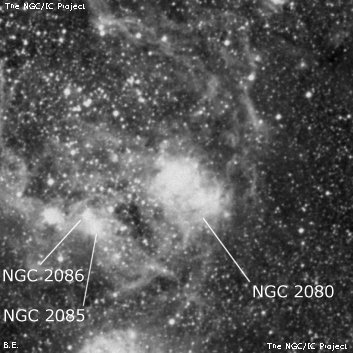
Along with NGC 2085 and 2086, another pair of knots ~3' SE, the entire complex is part of the Superbubble LMC-N160. Roughly 6' S is LMC-N159, another stunning group of nebulous glows consisting of NGC 2078, 2079, 2083 and 2084. NGC 2080 is the brightest region in the LMC-N159/160 complex and is nicknamed the "Ghost-Head Nebula" from a 2000 HST image.
At 350x the view was fascinating with 3 or 4 embedded "stars" (the brightest one or two appeared to be quasi-stellar knots) and NGC 2080 had a curdled texture. A couple of brighter mag 13/14 stars are off the NW side and a number of stars trail off to the east and NE (part of the O-association LH 103).
The two "eyes" of the Ghost Head (noted as quasi-stellar above) are rare, compact "high excitation blobs" (HEBs) of diameter ~3". They were discovered in 1986 and identified as A1 and A2, separated by ~20".
James Dunlop probably discovered NGC 2080 = D 145 or D 150 in 1826 and described D 145 as "the centre of a large cluster of extremely minute stars, with many very small nebulae in it." Dunlop's position falls just southwest of the NGC 2077/2080/2085/2086 association and just northwest of the NGC 2078/2079/2083 association, so he certainly observed several of these components and NGC 2080 is perhaps the brightest individual section. D 150 was recorded as "A well-defined round nebula, small. This precedes a group of nebulae." There is nothing at his position but NGC 2080 is 14' NW and it is on the west side of the complex, so fits the description.
John Herschel observed NGC 2080 = h2947 in Dec 1834 and logged "B; R; double; the other sp NGC 2077] is F; R; followed by clustering stars." An excellent sketch of the entire complex is on plate III, figure 4.
600/800mm - 24" (4/9/08 - Magellan Observatory, Australia): at 200x and UHC filter, this emission nebula is very impressive, appearing as an extremely bright nebulous glow with an irregular shape, ~1.5' diameter, slightly elongated. The brightest section is encased in a larger, fainter nebulous glow that extends mostly to the south. NGC 2077, a bright HII glow, is attached on the SW side with their centers just 1' apart. Located just 30' SSE of the center of the Tarantula Nebula!
Notes by Steve Gottlieb